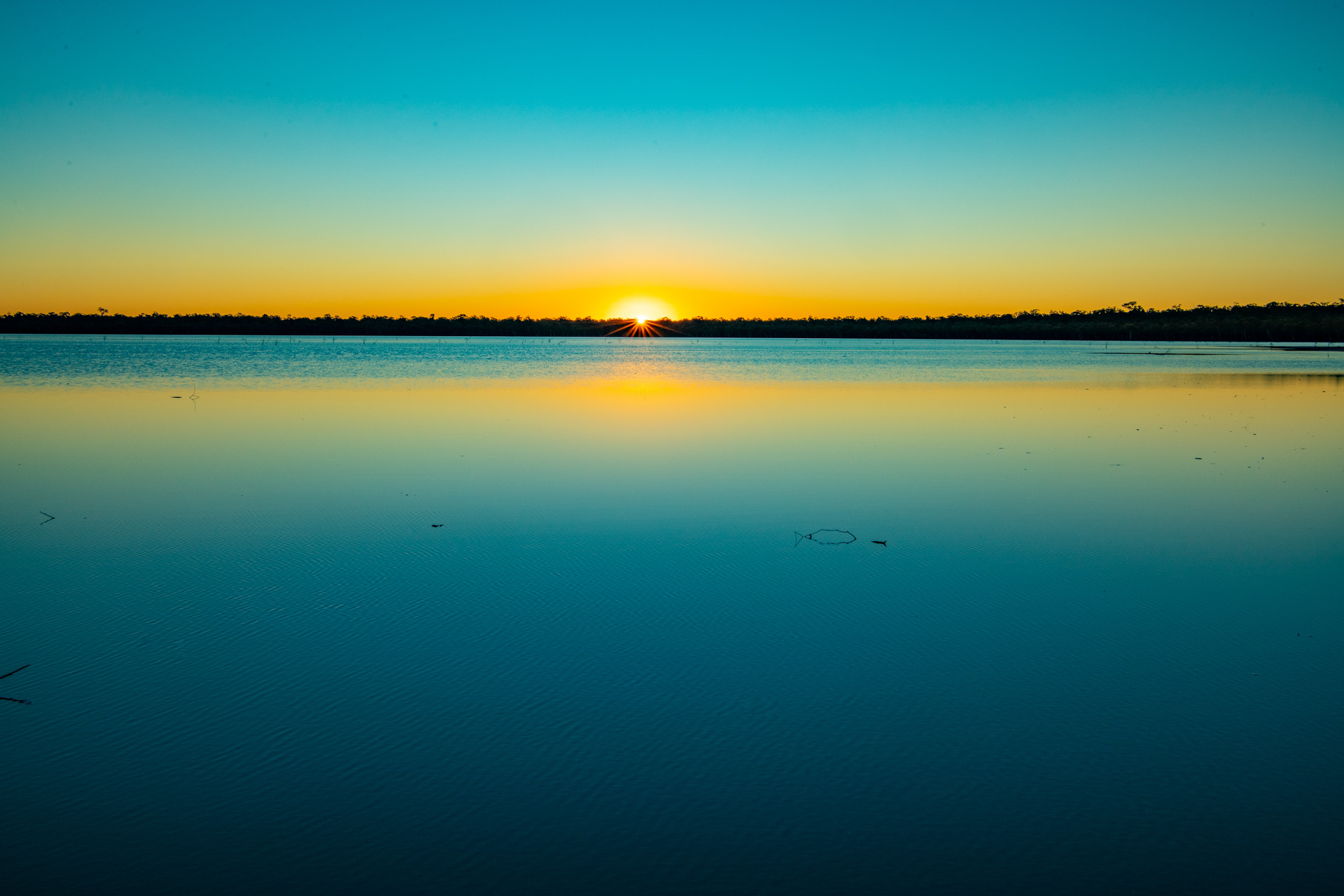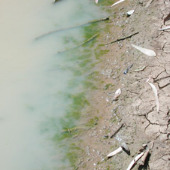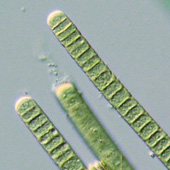|
|
LightLight is a form of electromagnetic radiation (energy) that can be detected by the human eye. Light is essential for organisms to see the world and to interact with it. Sunlight provides both the light and heat that warms all the spheres (atmosphere, hydrosphere and geosphere). Importantly, light powers primary production via photosynthesis. Light occupies the middle part of the electromagnetic spectrum, its wavelengths comprising the colours of the rainbow with the longer waves towards the red end of the spectrum and the shorter waves towards violet. Light waves have similar properties to other types of waves – they reflect off objects or are absorbed, scatter and refract or bend (splitting white light into its constituent rainbow colours). Due to its properties as a wave, light moves differently in the air and water.[7]
Plants and other autotrophs (primary producers) have photosynthetic pigments in their cells (chlorophylls) that absorb the different light spectra. Many chlorophylls absorb the red and blue spectra, reflecting green light, although there can be different pigments in the yellow and red end that reflect those light spectra. Plants and other organisms can also use ultraviolet light beyond the visible spectrum to speed up photosynthesis, however ultraviolet light can also damage some plants and animals. Some organisms such as corals have their own sunscreen to filter out ultraviolet light.
Role in wetlands functionSolar radiation, light and heating drive the weather patterns in the atmosphere and influences wind and precipitation patterns that determine wetland climate. The number of days of sunshine and its daily duration influences climatic patterns such as latitudinal climates, rainfall and evapotranspiration, all factors affecting the nature, extent and temporal duration of wetlands. Periodic light and dark cycles influence the timing of all life on the land and the sea. The diurnal and seasonal patterns of daylight are important physiological and seasonal controls over the biological clocks of all animals and plants, including wetland biota. In plants, sunlight periodicity and duration is important for determining reproductive cycles such as flowering times and controls cyclic growth periods associated with the seasons. In combination with daylight and the tides, light from the moon influences essential life processes (e.g. spawning) and movements (e.g. foraging) of sessile and mobile invertebrates and fish. Wetland plants (including water plants and suspended microalgae) and the vegetation surrounding wetlands all depend on light to carry out photosynthesis that forms the basis of the wetland food web. Sunlight and heat also contribute to evaporation of water in a wetland (see evapotranspiration). Shading is a critical factor for some wetland habitats, such as waterholes and pools, to maintain a suitable stable temperature for fish and invertebrates (example – Mary River Cod). Ambient sunlight available to aquatic plants is limited by 2 principal factors:
Sunlight is also critical for estuarine and marine plants such as seagrass and macroalgae and autotrophs such as corals. Corals have symbiotic dinoflagellate algae that need light to produce food for coral[8]. Coastal waters receive suspended fine sediment and nutrients in flood pulses that promote the growth of microscopic algae and the overgrowth of algae on seagrass meadows and coral-dominated ecosystems. The suspended sediment and microscopic algae in the water column can block the light, leading to the death of seagrass and corals. This has consequences for dependent turtles, dugongs, fish and other biota. Certain corals have adapted to coastal low light regimes as heterotrophs, consuming plankton food as well as creating their own food in a symbiotic partnership with dinoflagellates. They can achieve high levels of live coral cover despite living in periodically turbid waters. Examples include Goniopora and Turbinaria. However, if the light becomes too limited even these species do not survive poor coastal water quality. Suspended particles are the dominant influence on light penetration in most natural waters[3], with the exception of highly coloured waters where absorption can be more significant. Turbidity is a measurement of the degree to which light travelling through the water column is scattered by suspended organic and inorganic particles[5]. Turbidity increases with a greater suspended load and therefore reduces the depth to which sunlight penetrates the water. The higher the turbidity the greater this effect. The depth to which light penetrates is the photic depth of the water body. Below this depth there is insufficient light for plants to photosynthesise. The photic depth is shallow in highly turbid wetlands with primary production limited to floating or emergent plants and benthic, planktonic or submerged plants only within the shallow photic zone. Rates of primary production in deeper areas can be 2 orders of magnitude lower than in shallow littoral areas[1]. Primary production is then limited to the uppermost layers of the water. Where turbidity is high and light penetration subsequently low, phytoplankton assemblages are usually dominated by either flagellated eukaryotic algae or vacuolate cyanobacteria which are selectively favoured due to their ability to actively position themselves within a suitable light environment. Role in wetland managementThe impact of sediment on light availability for critical coastal ecosystems in the Great Barrier Reef, Moreton Bay and coastal areas of Queensland is the subject of significant management interventions and funding programs. Light provides powerful tools to managers to visualise, characterise and delineate wetlands. Visible remote sensing uses the properties of light to capture spatial and spectral information about wetland ecosystems, including the variability and periodicity of water extent in the wetland (see Wetland Insight tool). In clear waters optical remote sensing[4] is a powerful tool for the mapping of intertidal and subtidal ecosystems including coral reefs and seagrass meadows and for the bathymetry of the sea floor. Light (LiDAR) is an important tool for mapping 3D dimensions of trees and the relief of surfaces such as river channels and the intertidal area and the bathymetry of clear shallow subtidal substrates. Light passing through the water (water clarity) is measured by metrics including - Secchi depth, light attenuation, photosynthetically active radiation (PAR) or euphotic depth (measured as depth at which 1% of surface PAR remains). PAR is an important metric to gauge the potential for photosynthesis for branching corals and for seagrass meadows. Light requirement guidelines have been developed for seagrass on the Great Barrier Reef, including the amount of light per day and the number of consecutive light days. Colonising seagrass species that dominate deepwater habitats were found to be the most sensitive to light reduction[2]. Links and referencesSunshine: Average Daily Sunshine Hours (Australian Government Bureau of Meteorology) Pages under this sectionReferences
Last updated: 13 October 2023 This page should be cited as: Department of Environment, Science and Innovation, Queensland (2023) Light, WetlandInfo website, accessed 8 May 2025. Available at: https://wetlandinfo.des.qld.gov.au/wetlands/ecology/components/atmosphere-physical/light/ |

 — Department of the Environment, Tourism, Science and Innovation
— Department of the Environment, Tourism, Science and Innovation




